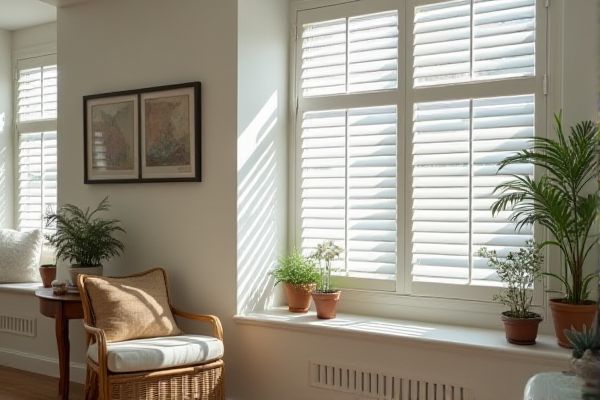
Plantation shutters offer a timeless, sturdy design with excellent light control and insulation, while Venetian blinds provide versatile, adjustable slats for quick light and privacy adjustments. Discover which window treatment best suits your style, functionality, and budget in the rest of this article.
Table of Comparison
| Feature | Plantation Shutters | Venetian Blinds |
|---|---|---|
| Material | Wood or faux wood | Aluminum, wood, or PVC |
| Light Control | Excellent, adjustable louvers | Good, adjustable slats |
| Privacy | High, full coverage | Moderate, partial coverage |
| Durability | Long-lasting, robust | Moderate, susceptible to damage |
| Maintenance | Easy, wipe clean | Requires frequent dusting |
| Installation | Permanent, professional recommended | Easy, DIY possible |
| Cost | Higher initial investment | More affordable |
| Aesthetic | Classic, elegant look | Modern, casual appearance |
| Energy Efficiency | Good insulation | Minimal insulation |
Overview: Plantation Shutters vs Venetian Blinds
Plantation shutters feature wide, solid louvers made from wood or composite materials, offering excellent light control and energy efficiency, while Venetian blinds consist of horizontal slats typically made from aluminum, wood, or PVC that provide versatile light adjustment and a modern aesthetic. Plantation shutters are known for their durability, insulation properties, and ability to enhance property value, whereas Venetian blinds are favored for their affordability, ease of installation, and wide range of styles and colors. Both window treatments improve privacy and light management but differ significantly in maintenance, lifespan, and overall visual impact.
Design and Aesthetic Appeal
Plantation shutters offer a timeless, elegant look with wide louvers that provide a clean, structured aesthetic ideal for both traditional and modern interiors. Venetian blinds feature narrow slats that allow for precise light control and add a sleek, contemporary touch, making them versatile for various room styles. Your choice between the two will significantly impact the overall design, with shutters enhancing architectural depth and blinds emphasizing minimalist sophistication.
Light Control and Privacy
Plantation shutters offer superior light control with adjustable louvers that allow precise regulation of sunlight entering a room, enhancing privacy while maintaining natural light. Venetian blinds provide flexible slat angles for light filtering, but gaps between slats may compromise total privacy compared to shutters. Both window treatments allow customizable light and privacy levels, but plantation shutters provide a more solid barrier and classic aesthetic.
Material Options and Durability
Plantation shutters are typically made from hardwoods such as basswood or composite materials like MDF, offering exceptional durability and resistance to warping, ideal for long-term use. Venetian blinds primarily use materials like aluminum, PVC, or wood, with aluminum providing excellent moisture resistance but less aesthetic warmth compared to wood options. The robust construction of plantation shutters generally results in a longer lifespan and better insulation compared to the lighter, more flexible design of Venetian blinds.
Energy Efficiency and Insulation
Plantation shutters offer superior energy efficiency and insulation due to their thick, solid louvers that reduce heat transfer and block drafts more effectively than Venetian blinds. Venetian blinds, typically made of thinner materials like aluminum or plastic, provide less insulation and allow more heat exchange, making them less effective in maintaining indoor temperature. Choosing plantation shutters can enhance Your home's energy performance by improving temperature control and reducing heating and cooling costs.
Ease of Cleaning and Maintenance
Plantation shutters offer a sleek, solid surface that makes cleaning straightforward with just a quick wipe using a damp cloth, reducing dust buildup and allergens effectively. Venetian blinds, composed of multiple thin slats, require more detailed cleaning, often involving dusting each slat individually to prevent grime accumulation. Your choice between these window treatments may hinge on how much time you want to invest in regular upkeep and maintaining a pristine appearance.
Installation Process and Flexibility
Plantation shutters require precise measurements and professional installation to ensure a seamless fit within your window frames, offering a sturdy and permanent solution. Venetian blinds provide greater flexibility with simpler, DIY-friendly installation and adjustable slats that allow you to easily control light and privacy. Your choice depends on whether you prioritize a long-term, elegant fixture or versatile, easily adjustable window treatments.
Cost Comparison: Shutters vs Blinds
Plantation shutters generally have a higher upfront cost, averaging $450 to $900 per window, compared to Venetian blinds, which typically range from $50 to $200 per window. While the initial investment for shutters is greater, their durability and low maintenance can lead to long-term savings, as blinds often require more frequent replacement. Homeowners seeking a cost-effective window treatment initially may prefer Venetian blinds, whereas those valuing a lasting investment may opt for plantation shutters.
Suitability for Different Room Types
Plantation shutters are ideal for living rooms and bedrooms where durability and light control are essential, offering a timeless look and excellent insulation. Venetian blinds suit kitchens and bathrooms better due to their moisture-resistant materials and ease of cleaning, providing flexible light adjustment. Your choice between these window treatments should consider the room's humidity, style preference, and maintenance needs.
Pros and Cons: Making the Right Choice
Plantation shutters offer superior light control, durability, and add value to your home, but they typically come with a higher upfront cost and less flexibility in adjusting slat angles compared to Venetian blinds. Venetian blinds provide versatile light regulation and affordability, with easy maintenance, but may lack the insulation properties and aesthetic appeal of shutters. Understanding your priorities in style, budget, and functionality will help you make the right choice for your space.
 homyna.com
homyna.com